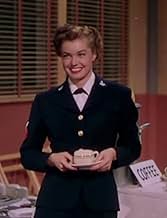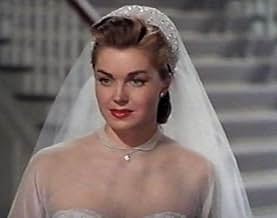Ajouter une intrigue dans votre langueThree women in three different situations report for induction at the Great Lakes Naval Training Station and end up roommates. What follows is a frothy and fun musical.Three women in three different situations report for induction at the Great Lakes Naval Training Station and end up roommates. What follows is a frothy and fun musical.Three women in three different situations report for induction at the Great Lakes Naval Training Station and end up roommates. What follows is a frothy and fun musical.
- Prix
- 1 victoire au total
The DeMarco Sisters
- The Williams Sisters
- (as The De Marco Sisters)
Dorothy Abbott
- WAC
- (uncredited)
Bette Arlen
- Bridesmaid
- (uncredited)
Avis en vedette
this movie was a disaster.the plot if there was one was pathetic. considering that many name stars were in this film it is amazing that it could be done so poorly.if boot camp were this easy we would lose all future wars. do yourself a favor don't watch this or your review might be worse than mine. to call this movie bad would be too polite.
A very dull musical, not comparable with what director Sidney Lanfield had made at 20th.Century Fox in the thirties. No wonder this was his last picture. An example of the difference between what the Freed unit and the Pasternak unit were doing at MGM at the time. Of course, Esther Williams was as beautiful as ever.
Even though I am a fan of Esther Williams, I found this film very uneven.
Skirts Ahoy! was released in 1952 when the U.S. was involved in the Korean conflict. The roles of women in society were changed significantly during WWII, which ended only about five years before. The country was adjusting quickly and creating social phenomena (the baby boom, the suburban real estate boom, and a search for equilibrium in the roles of the sexes) that would be studied for decades. Esther Williams, Vivian Blaine and Joan Evans play three Waves in training at the Great Lakes U.S. Naval Training Center. They are rather aggressive in pursuit of men--an attitude that many men would find off-putting, especially in the early 50s.
Barry Sullivan plays the navy physician that Esther Williams pursues. I found his performance drab, making it difficult to understand her fascination with him.
Vivian Blaine practically plays Miss Adelaide from Guys and Dolls here, a role she perfected on Broadway in 1950 and, later, in the film (1955).
Esther gets her moments in the pool, of course. As usual, the aqua routines are not really a part of the overall plot. And the studio managed to throw in a number of music and dance numbers that are the same way, so that Esther is an audience member during them. It's pretty remarkable that the local dinner club features Billy Eckstine. In a show on the base, we find Keenan Wynn, Debbie Reynolds, Bobby Van and a full selection of orchestra, drill teams, and choral groups.
The dance number featuring Debbie and Bobby was fun. Both are so fresh that their roles are uncredited. Singin' in the Rain was released in the same year, so who knew Debbie would be such a hit when Skirts Ahoy! came to theaters?
I particularly enjoyed the performances of the (5) DeMarco Sisters. Great harmonies, great energy.
The film has an improbable resolution, but the entire plot is merely a device to separate the swimming and musical numbers.
Skirts Ahoy! was released in 1952 when the U.S. was involved in the Korean conflict. The roles of women in society were changed significantly during WWII, which ended only about five years before. The country was adjusting quickly and creating social phenomena (the baby boom, the suburban real estate boom, and a search for equilibrium in the roles of the sexes) that would be studied for decades. Esther Williams, Vivian Blaine and Joan Evans play three Waves in training at the Great Lakes U.S. Naval Training Center. They are rather aggressive in pursuit of men--an attitude that many men would find off-putting, especially in the early 50s.
Barry Sullivan plays the navy physician that Esther Williams pursues. I found his performance drab, making it difficult to understand her fascination with him.
Vivian Blaine practically plays Miss Adelaide from Guys and Dolls here, a role she perfected on Broadway in 1950 and, later, in the film (1955).
Esther gets her moments in the pool, of course. As usual, the aqua routines are not really a part of the overall plot. And the studio managed to throw in a number of music and dance numbers that are the same way, so that Esther is an audience member during them. It's pretty remarkable that the local dinner club features Billy Eckstine. In a show on the base, we find Keenan Wynn, Debbie Reynolds, Bobby Van and a full selection of orchestra, drill teams, and choral groups.
The dance number featuring Debbie and Bobby was fun. Both are so fresh that their roles are uncredited. Singin' in the Rain was released in the same year, so who knew Debbie would be such a hit when Skirts Ahoy! came to theaters?
I particularly enjoyed the performances of the (5) DeMarco Sisters. Great harmonies, great energy.
The film has an improbable resolution, but the entire plot is merely a device to separate the swimming and musical numbers.
It may not be front rank, but the production is doing what glossy MGM did best—musicals. Of course with the aquatic Esther Williams, we know some of the music will accompany her acrobatic swim skills. The first half are the three girls getting accustomed to military life with the usual plucked heartstrings, while musical numbers dominate the second half. As expected, the results are lavishly produced in candy box Technicolor. Ordinarily, a patriotically themed production like this would be WWII movie fare, but keep in mind in '52 and '53 the Korean War was still dragging on, though it's never mentioned in the screenplay.
The pacing is zippy, not letting the boy-girl interludes slow things down. Still, the musical selections are largely forgettable, while the set pieces are many and not too well blended. My favorites are The Debbie Reynolds-Bobby Van cameo, a good acrobatic contrast to the various marching numbers. Apparently MGM liked the result well enough to team them in the following year's beguiling The Affairs of Dobie Gillis (1953). Also, Williams' underwater shenanigans with the two kids is certainly eye-catching and different. (Too bad the little girl died a couple months later in a diving accident {IMDB}.)
It's an able cast from a patrician Williams to a goofy Blaine to an unpredictable Evans. But when I think musicals, I don't think Barry Sullivan. Looks like he was breaking with his sinister image by playing a no-nonsense doctor; at the same time, not looking too comfortable. And, oh yes, the brief interludes between Williams and the beguiled old guy amount to an inspired poignant touch.
All in all, it's an entertaining, if crowded, 109-minutes that probably tries to do too much for its own good. No it's not among Williams' best, still the pacing and visuals zip along in fine fashion such that if you don't like this set-up, a new one will soon follow.
The pacing is zippy, not letting the boy-girl interludes slow things down. Still, the musical selections are largely forgettable, while the set pieces are many and not too well blended. My favorites are The Debbie Reynolds-Bobby Van cameo, a good acrobatic contrast to the various marching numbers. Apparently MGM liked the result well enough to team them in the following year's beguiling The Affairs of Dobie Gillis (1953). Also, Williams' underwater shenanigans with the two kids is certainly eye-catching and different. (Too bad the little girl died a couple months later in a diving accident {IMDB}.)
It's an able cast from a patrician Williams to a goofy Blaine to an unpredictable Evans. But when I think musicals, I don't think Barry Sullivan. Looks like he was breaking with his sinister image by playing a no-nonsense doctor; at the same time, not looking too comfortable. And, oh yes, the brief interludes between Williams and the beguiled old guy amount to an inspired poignant touch.
All in all, it's an entertaining, if crowded, 109-minutes that probably tries to do too much for its own good. No it's not among Williams' best, still the pacing and visuals zip along in fine fashion such that if you don't like this set-up, a new one will soon follow.
SKIRTS AHOY! (1952) is musical-comedy fluff aimed mostly at a female audience, but it's not too bad. It's pleasant enough and some of the songs by Harry Warren and Ralph Blane are fun ("What Makes a Wave?", "What Good Is a Gal?"). MGM's swimming superstar Esther Williams, "Guys and Dolls" standout Vivian Blaine, and Joan Evans join the Navy to escape their man troubles. Esther Williams performs a couple of dry-land musical numbers, but the script still finds time for her to visit the pool. In one scene she's accompanied by a couple pint-sized swimming prodigies (brother and sister Russell and Kathy Tongay). Keenan Wynn, Debbie Reynolds, and Bobby Van make celebrity cameos.
Le saviez-vous
- AnecdotesKathy Tongay, the little girl with whom Esther Williams swims in one sequence, died shortly before her sixth birthday just a year after the film was released, after suffering fatal internal injuries after her swimming coach father instructed her to make a dive from a 33-foot-high platform in Florida. (Her older brother Russell 'Bubba' Tongay, also appears in the sequence; the brother/sister team performed as The Aquatots). Following the tragic dive, their father was sentenced to ten years in prison on child-endangerment related charges.
- GaffesJeff Donnell is credited as Lt. Giff, but introduces herself as Chief Giff when the ladies first arrive at Great Lakes. She also wears the rank of a Chief Petty Officer (noncommissioned officer) and not of a Navy Lieutenant (commissioned officer).
- Citations
Whitney Young: You said the one thing in your life was Dick.
- ConnexionsReferenced in I vinti (1953)
- Bandes originalesSkirts Ahoy!
(uncredited)
Music by Harry Warren
Lyrics by Ralph Blane
[Performed by female chorus over opening titles; played instrumentally behind the black drill team]
Meilleurs choix
Connectez-vous pour évaluer et surveiller les recommandations personnalisées
- How long is Skirts Ahoy!?Propulsé par Alexa
Détails
Box-office
- Budget
- 2 000 000 $ US (estimation)
- Durée1 heure 49 minutes
- Rapport de forme
- 1.37 : 1
Contribuer à cette page
Suggérer une modification ou ajouter du contenu manquant

Lacune principale
By what name was Skirts Ahoy! (1952) officially released in India in English?
Répondre

































